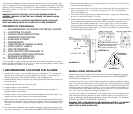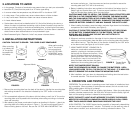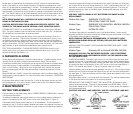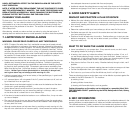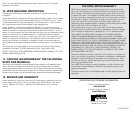
have adequate insurance to protect their lives and property.
•Install and maintain fire extinguishers on every level of the home and in the kitchen,
basement and garage. Know how to use a fire extinguisher prior to an emergency.
8. GOOD SAFETY HABITS
DEVELOP AND PRACTICE A PLAN OF ESCAPE
•Make a floor plan indicating all doors and windows and at least two (2) escape
routes from each room. Second story windows may need a rope or chain ladder.
•Have a family meeting and discuss your escape plan, showing everyone what to
do in case of fire.
• Determine a place outside your home where you all can meet if a fire occurs.
• Familiarize everyone with the sound of the smoke alarm and train them to leave
your home when they hear it.
•Practice a fire drill at least every six months. Practice allows you to test your plan
before an emergency. You may not be able to reach your children. It is important
they know what to do.
WHAT TO DO WHEN THE ALARM SOUNDS
• Leave immediately by your escape plan. Every second counts, so don’t waste
time getting dressed or picking up valuables.
•In leaving, don’t open any inside door without first feeling its surface. If hot, or if
you see smoke seeping through cracks, don’t open that door! Instead, use your
alternate exit. If the inside of the door is cool, place your shoulder against it, open
it slightly and be ready to slam it shut if heat and smoke rush in.
•Stay close to the floor if the air is smoky. Breathe shallowly through a cloth, wet if
possible.
•Once outside, go to your selected meeting place and make sure everyone is there.
•Call the fire department from your neighbor’s home - not from yours!
• Don’t return to your home until the fire officials say that it is all right to do so.
There are situations where a smoke alarm may not be effective to protect against fire
as stated in the NFPA Standard 72. For instance:
a) smoking in bed
b) leaving children home alone
c) cleaning with flammable liquids, such as gasoline
Further information on fire safety can be obtained in a pamphlet titled “IN A
FIRE SECONDS COUNT” published by the NFPA, Batterymarch Park, Quincy,
MA 02269
9. NRC INFORMATION
Ionization type smoke alarms use a very small amount of a radioactive element in the
sensing chamber to enable detection of visible and invisible combustion products.
The radioactive element is safely contained in the chamber and requires no adjust-
ments or maintenance. This smoke alarm meets or exceeds all government stan-
HAVE A DETRIMENTAL EFFECT ON THE SMOKE ALARM OR THE SAFETY
LIGHT OPERATION.
NOTE: IF AFTER BATTERY REPLACEMENT THE UNIT CONTINUES TO CHIRP,
WAIT FOR APPROXIMATELY 7 MINUTES. THE “HUSH” FEATURE MAY HAVE
BEEN ACTIVATED ACCIDENTALLY WHILE CHANGING THE BATTERIES AND
PUSHING THE TEST BUTTON WILL END THE HUSH CYCLE.
CLEANING YOUR ALARM
To clean your alarm, remove it from the mounting bracket as outlined in the beginning
of this section. You can clean the interior of your alarm (sensing chamber) by using
compressed air or a vacuum cleaner hose and blowing or vacuuming through the
openings around the perimeter of the alarm. The outside of the alarm can be wiped
with a damp cloth.
After cleaning, reinstall your alarm and test your alarm by using the test button. If
cleaning does not restore the alarm to normal operation, the alarm should be replaced.
7. LIMITATIONS OF SMOKE ALARMS
WARNING: PLEASE READ CAREFULLY AND THOROUGHLY
•NFPA 72 states: Life safety from fire in residential occupancies is based primarily
on early notification to occupants of the need to escape, followed by the appropri-
ate egress actions by those occupants. Fire warning systems for dwelling units are
capable of protecting about half of the occupants in potentially fatal fires. Victims
are often intimate with the fire, too old or young, or physically or mentally impaired
such that they cannot escape even when warned early enough that escape should
be possible. For these people, other strategies such as protection-in-place or
assisted escape or rescue are necessary.
•Smoke alarms are devices that can provide early warning of possible fires at a rea-
sonable cost; however, alarms have sensing limitations. Ionization type alarms
offer a broad range of fire sensing capabilities but are better at detecting fast flam-
ing fires than slow smoldering fires. Photoelectric alarms sense smoldering fires
better than flaming fires. Home fires develop in different ways and are often unpre-
dictable. Neither type of alarm (photoelectric or ionization) is always best,
and a given alarm may not always provide warning of a fire.
•A battery powered alarm must have a battery of the specified type, in good condi-
tion and installed properly.
•A.C. powered alarms will not operate if the A.C. power has been cut off, such as
by an electrical fire or an open fuse.
•Smoke alarms must be tested regularly to make sure the batteries and the alarm
circuits are in good operating condition.
•Smoke alarms cannot provide an alarm if smoke does not reach the alarm.
Therefore, smoke alarms may not sense fires starting in chimneys, walls, on roofs,
on the other side of a closed door or on a different floor.
• If the alarm is located outside the bedroom or on a different floor, it may not wake
up a sound sleeper.
• The use of alcohol or drugs may also impair one’s ability to hear the smoke alarm.
For maximum protection, a smoke alarm should be installed in each sleeping area
on every level of a home.
•Although smoke alarms can help save lives by providing an early warning of a fire,
they are not a substitute for an insurance policy. Home owners and renters should




